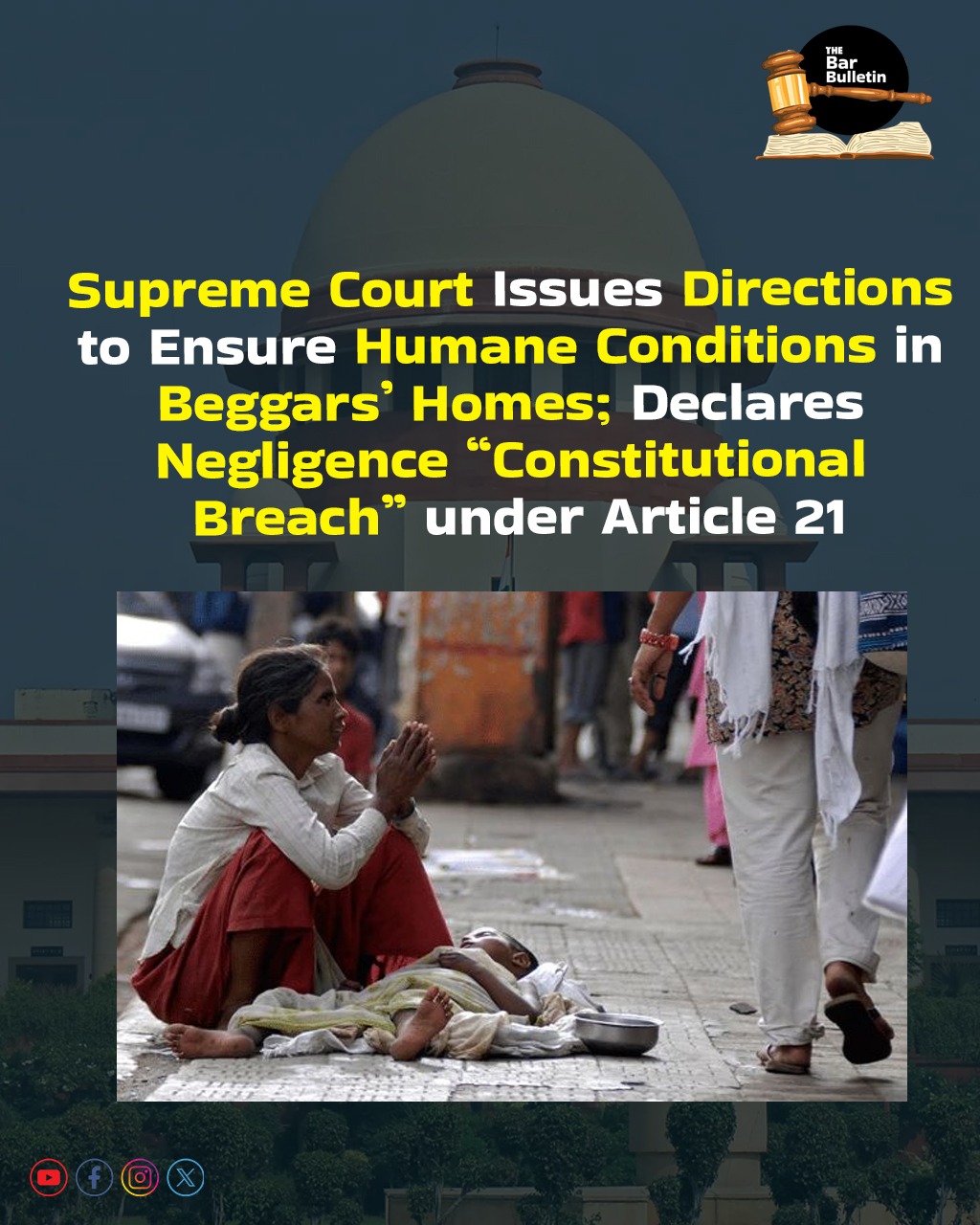The Supreme Court on September 12, 2025, partially allowed a PIL filed under Article 21 concerning the living conditions and deaths of beggars in a state institution due to poor sanitation and living conditions. The Division Bench, comprising Justices J.B. Pardiwala and R. Mahadevan, acknowledged the respondents’ accountability and further expanded its reasoning to mandate nationwide systemic reforms, issuing directions on healthcare, sanitation, infrastructure, and other measures for all Beggars’ Homes across the country.
The appellant filed a PIL on 17th May 2000 after learning that 107 patients from Lampur (Narela) Beggars’ Home were hospitalized with gastroenteritis and cholera, and six had died. Invoking the Right to Life with Dignity under Article 21, the appellant prayed to the High Court for: (i) a writ of mandamus under Article 226 to fix responsibility for the deaths, (ii) compensation of at least ₹5,00,000 per deceased to their dependents, and (iii) appropriate punishment for the officials or subordinates responsible, whether severally or jointly.On 1st June 2000, the ADM reported to the Government that the deaths of inmates at Lampur Beggars’ Home were due to contaminated water, holding both the institution’s authorities and the PWD responsible.The High Court directed a committee from Som Datt & Ors v. NCT of Delhi (CWP No. 667/1997) to investigate. The committee’s findings, along with the respondents’ affidavits, confirmed a cholera outbreak caused by contaminated water, negligence by superintendents, and PWD failures, including non-functional generators. Though no post-mortems were conducted, the deaths were linked to cholera. Two officials were suspended and faced departmental proceedings, with responsibility fixed and proceedings ordered to conclude within six months. The Court also directed the government to make the Home habitable in line with committee recommendations.
The appellant alleged that the Minister of Social Welfare and the Superintendent concealed facts regarding the deaths of the inmates. Furthermore she also contended that the committee only submitted an interim report in January 2001 highlighting grave lapses—including contaminated water, unfit food, assaults, forced labor—but was denied time for a final report.Furthermore, that the respondents misled the Court and NHRC with false reports, ignored the Vigilance Director’s letter, failed to hold officers accountable, and that systemic issues persisted in Beggars’ Homes, urging stronger oversight and genuine reforms.The respondents argued that remedial measures were ongoing, with disciplinary action completed for delinquent officials and delays only due to procedural requirements.
The Court noted that while tangible improvements according to the respondents’ report had been made in Beggars’ Homes, such reforms should extend to all similar institutions nationwide to secure the constitutional right to life with dignity. It emphasized that Beggars’ Homes must shift from instruments of control to spaces of social justice, and issued nationwide directions to ensure humane conditions are maintained. Therefore the Court while citing State of Uttar Pradesh v. Brahm Datt Sharma (1987) 2 SCC 179, Francis Coralie Mullin v. Administrator, Union Territory of Delhi (1981) 1 SCC 608, Inhuman Conditions in 1382 Prisons, In Re (2016) 3 SCC 700 and Harsh Mander v. Union of India AIR 2018 Del 188 issued the following directions which included-
• Preventive healthcare measures such as mandatory medical screening within 24 hours of admission, monthly health check-ups, disease surveillance systems, and strict hygiene standards guaranteeing potable water, functional toilets, and pest control.
• In terms of infrastructure, the Court mandated independent third-party audits every two years, prohibition of overcrowding, and provision of safe housing, ventilation, and open spaces.
• For nutrition and food safety, every Home must appoint a qualified dietician and follow standardized dietary protocols.
• On vocational training and rehabilitation, the Court directed the setting up of skill-based programmes, partnerships with NGOs and private agencies for employment-oriented training, and periodic assessments to aid reintegration of released inmates. Legal aid and awareness were also emphasized, with inmates to be informed of their rights and panel lawyers visiting Homes at least once in three months.
• Special provisions were laid down for women and children, requiring separate facilities with privacy, safety, childcare, education, and counselling, while children found begging were to be referred to child welfare institutions under the JJ Act, 2015 rather than kept in Beggars’ Homes.
• For accountability and oversight, States and Union Territories must establish Monitoring Committees comprising officials and civil society members to publish annual reports, maintain records of illnesses and deaths, and ensure compensation and disciplinary or criminal action in cases of negligence leading to inmate deaths.
• Implementation and compliance were strengthened by requiring a centralized digital database of inmates and mandating that all directions be carried out within six months. The Union of India, through the Ministry of Social Justice and Empowerment, was directed to frame model guidelines within three months for uniform application across the country, while the Registrar (Judicial) was tasked with circulating the judgment to all Chief Secretaries and the Union Ministry for compliance. Finally, liberty was reserved for the parties to approach the Court should any difficulties arise in the course of implementation.
The Court after issuing the aforementioned observations, disposed of the appeal and any pending applications with no order as to costs.

